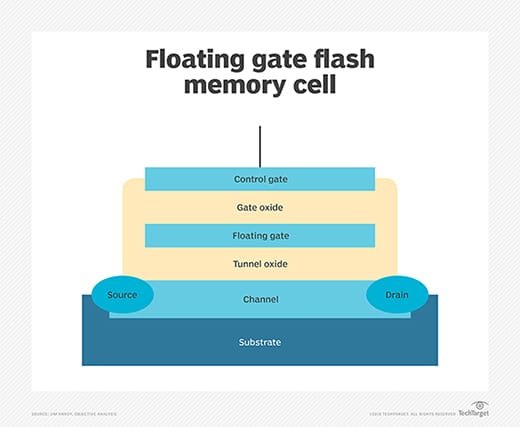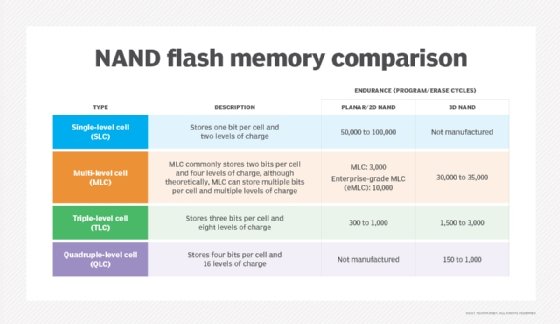
write endurance
What is write endurance?
Write endurance is the number of program/erase cycles, or P/E cycles, that can be applied to a block of flash memory before the storage media becomes unreliable.
NAND flash wears out because the oxide layer that isolates the floating gates in a flash memory chip is compromised after repeated P/E cycles. The floating gates are important because they store the electrical charge that indicates the state of each bit in a flash memory cell.
For instance, in single-level cell (SLC) flash, each bit is a 0 or a 1. When the insulating layer has sustained enough damage, the bit cells may not retain the right charge. 1s may become 0s, and the data on the storage media becomes corrupt.
Write amplification is one major challenge that solid-state drives (SSDs) face compared with hard disk drives (HDDs). Write amplification happens because the way SSDs read and erase data results in many extra P/E cycles being used for data medication operations.

How to measure SSD endurance
Write endurance and reliability of SSDs using flash storage are calculated by estimating how often and how thoroughly the flash media is used.
Some manufacturers provide an estimate of longevity based on an arbitrary amount of data written and erased per day. Other vendors simply provide an estimate of the mean time to failure (MTTF) without stipulating how they have arrived at the estimate. MTTF and mean time between failure are more often associated with HDDs.
Three metrics are used in defining write endurance:
- total terabytes (TB) written over time;
- drive writes per day (DWPD), the number of write cycles per day that the entire data storage device can handle; and
- the age of the device.
SanDisk, now part of Western Digital, has proposed an industry metric for write endurance called Long-term Data Endurance. This metric has a data retention period of one year. It is based on a predetermined use pattern that assumes the data is written equally over the lifetime of the drive and its workload.
How write endurance works
SSD endurance can be defined as the performance of a flash SSD under warranty. It specifically refers to the maximum amount of data that can be written to the device.
Metrics to measure write endurance are a function of the number of P/E cycles and represent the reliability of a device. P/E cycles vary with the type of NAND flash used. SLC NAND has 100,000 P/E cycles, while multi-level cell, or MLC, NAND has 10,000 P/E cycles and triple-level cell, or TLC, has 3,000 P/E cycles.

With each P/E cycle, a device's endurance decreases. As a result, it is important to determine the likely usage of an SSD before selecting a product.
For example, if an SSD manufacturer specifies 1 TB for 1 DWPD, this means the drive can handle 1 TB of data written to it each day during the warranty period. Similarly, a 10 TB drive handles 10 TB of writes per day for the warranty period.
Ways to increase write endurance and SSD life span
Techniques for increasing flash endurance include the following:
- Error correction code (ECC) corrects random bit error and reduces wear. Using ECC lengthens the usable life span of flash cells.
- Using firmware to manage an SSD is an efficient way to extend a drive's useful life.
- Overprovisioning adds flash capacity to a drive that is not visible to the user and uses firmware to increase endurance via better data management.
- Wear leveling is a controller-based load balancer that aims to distribute P/E cycles across the cells in a disk.
- Garbage collection is a background operation that consolidates data and erases it, helping the disk perform better.
What to consider when buying an SSD
Determining endurance requirements can have a direct impact on the cost of SSD flash drives. Specifically, the greater the endurance as specified by the manufacturer, the higher the cost.
This greater endurance increases a device's usable life. However, the added cost must be factored against that longer life span. Conversely, selecting a device with insufficient endurance may result in the premature failure of the SSD. This could result in the added risk of data loss or damage to stored data on the device. The added cost of device replacement should also be considered.
Follow these four steps when selecting an SSD:
- Examine existing system performance data to determine the average amount of data written each day for the server or device in question.
- Multiply that value by the number of days the device is likely to be in service during the year.
- The result is the baseline write endurance limit for selecting a device.
- Add more capacity to ensure that any higher-than-usual data writing cycles can be accommodated and the total amount of data can be validated.
Learn more about flash memory architecture, types and uses in this comprehensive guide.








